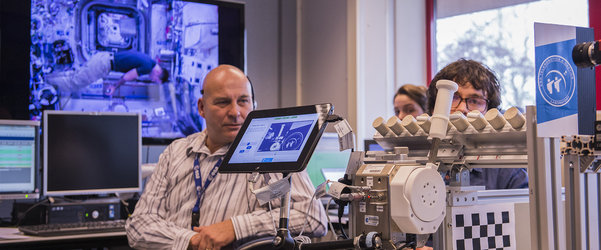Accept all cookies Accept only essential cookies See our Cookie Notice

About ESA
The European Space Agency (ESA) is Europe’s gateway to space. Its mission is to shape the development of Europe’s space capability and ensure that investment in space continues to deliver benefits to the citizens of Europe and the world.
Highlights
ESA - United space in Europe
This is ESA ESA facts Member States & Cooperating States Funding Director General Top management For Member State Delegations European vision European Space Policy ESA & EU Space Councils Responsibility & Sustainability Annual Report Calendar of meetings Corporate newsEstablishments & sites
ESA Headquarters ESA ESTEC ESA ESOC ESA ESRIN ESA EAC ESA ESAC Europe's Spaceport ESA ESEC ESA ECSAT Brussels Office Washington OfficeWorking with ESA
Business with ESA ESA Commercialisation Gateway Law at ESA Careers Cyber resilience at ESA IT at ESA Newsroom Partnerships Merchandising Licence Education Open Space Innovation Platform Integrity and Reporting Administrative Tribunal Health and SafetyMore about ESA
History ESA Historical Archives Exhibitions Publications Art & Culture ESA Merchandise Kids Diversity ESA Brand Centre ESA ChampionsLatest
Space in Member States
Find out more about space activities in our 23 Member States, and understand how ESA works together with their national agencies, institutions and organisations.
Science & Exploration
Exploring our Solar System and unlocking the secrets of the Universe
Go to topicAstronauts
Missions
Juice Euclid Webb Solar Orbiter BepiColombo Gaia ExoMars Cheops Exoplanet missions More missionsActivities
International Space Station Orion service module Gateway Concordia Caves & Pangaea BenefitsLatest
Space Safety
Protecting life and infrastructure on Earth and in orbit
Go to topicAsteroids
Asteroids and Planetary Defence Asteroid danger explained Flyeye telescope: asteroid detection Hera mission: asteroid deflection Near-Earth Object Coordination CentreSpace junk
About space debris Space debris by the numbers Space Environment Report In space refuelling, refurbishing and removingSafety from space
Clean Space ecodesign Zero Debris Technologies Space for Earth Supporting Sustainable DevelopmentLatest
Applications
Using space to benefit citizens and meet future challenges on Earth
Go to topicObserving the Earth
Observing the Earth Future EO Copernicus Meteorology Space for our climate Satellite missionsCommercialisation
ESA Commercialisation Gateway Open Space Innovation Platform Business Incubation ESA Space SolutionsLatest
Enabling & Support
Making space accessible and developing the technologies for the future
Go to topicBuilding missions
Space Engineering and Technology Test centre Laboratories Concurrent Design Facility Preparing for the future Shaping the Future Discovery and Preparation Advanced Concepts TeamSpace transportation
Space Transportation Ariane Vega Space Rider Future space transportation Boost! Europe's Spaceport Launches from Europe's Spaceport from 2012Latest

Feel the force
Thank you for liking
You have already liked this page, you can only like it once!
Going to space equals stress. As launcher propellant tanks are filled with fuel, or spacecraft structural panels experience the strain of orbital ascent, they undergo major force loading in multiple directions at once.
ESA’s new Bi-Axial Test Facility – installed at the Agency’s Materials and Electrical Components Laboratory at its ESTEC technical centre in the Netherlands – replicates the bi-directional application of load, allowing higher-fidelity testing of candidate materials for space missions.
“This is a new add-on to our existing Instron hydraulic test system, which is able to apply up to 250 kilonewtons of force in a single direction,” explains ESA materials engineer Donato Girolamo, who commissioned the design of the new facility to fulfil space material testing requirements.
“This extra jig works somewhat like a car jack. It has four rotating arms connected to sliding clamps onto the sides of the test item. Then as the hydraulic load is applied these arms rotate and the clamps slide outwards, pulling the material out along all four directions, to apply loading in both the x and y axes.”
Such bi-axial testing is especially valuable for composite structures, widely used in space, which can possess differing material properties along different directions.
The custom-made tooling for the new facility was designed and built by Enduteq in the Netherlands.
The Bi-Axial Test Facility will begin by investigating the performance of solid rocket motor cases. It would also be suited to testing materials making up structural panels, as well as those for pressure chambers of all kinds, from propellant tanks to crewed modules.
“This expansion of our capabilities allows us to reproduce the real load conditions facing our test materials and structures more closely than ever,” remarks Tommaso Ghidini, heading ESA’s Structures, Mechanisms and Materials Division.
“This is one example of how we are continuously working to enhance our testing capabilities to better serve our customers, shrink uncertainty margins and improve the performance of European spacecraft and systems.”
-
CREDIT
ESA-D. Girolamo -
LICENCE
ESA Standard Licence

Haptics-2 experiment

ExoMars EDM

Thomas feels home

IXV splashdown testing















 Germany
Germany
 Austria
Austria
 Belgium
Belgium
 Denmark
Denmark
 Spain
Spain
 Estonia
Estonia
 Finland
Finland
 France
France
 Greece
Greece
 Hungary
Hungary
 Ireland
Ireland
 Italy
Italy
 Luxembourg
Luxembourg
 Norway
Norway
 The Netherlands
The Netherlands
 Poland
Poland
 Portugal
Portugal
 Czechia
Czechia
 Romania
Romania
 United Kingdom
United Kingdom
 Slovenia
Slovenia
 Sweden
Sweden
 Switzerland
Switzerland
























